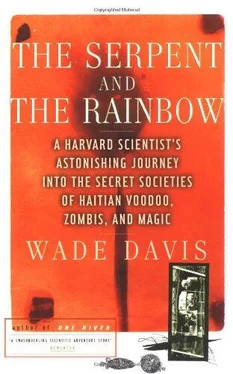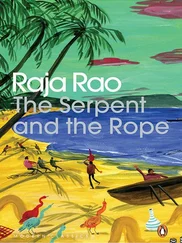Wade Davis - The Serpent and the Rainbow
Здесь есть возможность читать онлайн «Wade Davis - The Serpent and the Rainbow» весь текст электронной книги совершенно бесплатно (целиком полную версию без сокращений). В некоторых случаях можно слушать аудио, скачать через торрент в формате fb2 и присутствует краткое содержание. Год выпуска: 1985, Издательство: Simon & Schuster, Жанр: Старинная литература, на английском языке. Описание произведения, (предисловие) а так же отзывы посетителей доступны на портале библиотеки ЛибКат.
- Название:The Serpent and the Rainbow
- Автор:
- Издательство:Simon & Schuster
- Жанр:
- Год:1985
- ISBN:нет данных
- Рейтинг книги:5 / 5. Голосов: 1
-
Избранное:Добавить в избранное
- Отзывы:
-
Ваша оценка:
- 100
- 1
- 2
- 3
- 4
- 5
The Serpent and the Rainbow: краткое содержание, описание и аннотация
Предлагаем к чтению аннотацию, описание, краткое содержание или предисловие (зависит от того, что написал сам автор книги «The Serpent and the Rainbow»). Если вы не нашли необходимую информацию о книге — напишите в комментариях, мы постараемся отыскать её.
The Serpent and the Rainbow — читать онлайн бесплатно полную книгу (весь текст) целиком
Ниже представлен текст книги, разбитый по страницам. Система сохранения места последней прочитанной страницы, позволяет с удобством читать онлайн бесплатно книгу «The Serpent and the Rainbow», без необходимости каждый раз заново искать на чём Вы остановились. Поставьте закладку, и сможете в любой момент перейти на страницу, на которой закончили чтение.
Интервал:
Закладка:
As the essence of one’s individuality, the ti bon ange is the logical target of sorcery, a danger that is compounded by the ease and frequency with which it dissociates from the body. It is the ti bon ange, for example, that travels during sleep to experience dreams. Similarly, the brief sensation of emptiness that immediately follows a sudden scare is due to its temporary flight. And predictably it is the ti bon ange that is displaced during possession when the believer takes on the persona of the loa.
At the same time, because it is the ti bon ange that experiences life, it represents a precious accumulation of knowledge that must not be squandered or lost. If and only if it is protected from sorcery and permitted to complete its proper cycle, the ti bon ange may be salvaged upon the death of the individual and its legacy preserved. Only in this way may the wisdom of past lives be marshaled to serve the pressing needs of the living. A great deal of ritual effort, therefore, must be expended to secure its safe and effortless metamorphosis. At initiation, for example, the ti bon ange may be extracted from the body and housed in a canari , a clay jar that is placed in the inner sanctum of the hounfour. In this way the ti bon ange may continue to animate the living while remaining directly within the protective custody of the houngan. Yet even here there are no guarantees. Though it is difficult to kill the one whose ti bon ange has been placed in a canari, if the magic used against the individual is strong enough, the resulting misery may be so great that he will ask the houngan to release the soul that he might end his ordeal. And even if the individual does survive life, he is still at risk in death, for with the demise of the corps cadavre the houngan must break the canari so that the ti bon ange may return to hover about the body for seven days. Then, since the vodounist does not believe in the physical resurrection of the body, the soul must be definitively separated from the flesh, and this takes place during the Dessounin , which is the major death ritual. Throughout this period the ti bon ange is extremely vulnerable, and it is not until it is liberated from the flesh to descend below the dark abysmal waters that it is relatively safe.
The ti bon ange remains below in the world of Les Invisibles for one day and one year and then, in one of the most important of vodoun ceremonies—the Wété Mo Nan Dlo— it is reclaimed by the living and given new form. In place of the body that has decayed, the soul, now regarded as an “esprit,” is deposited in another clay jar called a govi . To the Haitian this reclamation of the dead is not an isolated sentimental act; on the contrary, it is considered as fundamental and inescapable as birth itself. One emerges from the womb an animal, the spiritual birth at initiation makes one human, but it is this final reemergence that marks one’s birth as divine essence. The spirits in the govi are fed and clothed and then released to the forest to dwell in trees and grottos, where they wait to be reborn. After the last of sixteen incarnations, the esprit goes to Damballah Wedo, where it becomes undifferentiated as part of the Djo , the cosmic breath that envelops the universe.
This lengthy passage of the ti bon ange corresponds to the metamorphosis of the individual human into pure spiritual energy. Hence, with the successive passing of generations, the individual identified with the esprit in the govi is transformed from the ancestor of a particular lineage into the generalized ancestor of all mankind. Yet even this pure spiritual energy must be made to serve, and for it to function it must become manifest. Thus from the ancestral pool there emerge archetypes, and these are the loa. It is, of course, possession, the return of the spirits to the body of man, that completes the sacred cycle: from man to ancestor, ancestor to cosmic principle, principle to personage, and personage returning to displace the identity of man. Hence, while the vodounist serves his gods, he also gives birth to them, and this is something that is never forgotten; as much as the spirit is the source of the flesh, so the flesh gives rise to the spirit. In place of opposition between the two, there is mutual dependence. Thus the regular arrival of the divine is not considered miraculous, but rather inevitable.
Within this cosmic exchange, perhaps man’s most critical contribution is the preservation of his own equilibrium, for without it the receptacle of the gods is placed in danger. The ideal form of man, therefore, is one of coherence, wherein all the sacred components of the individual find their proper place. The maintenance or restoration of this balance is the duty of the houngan, and it accounts for his unique role as healer. In our secular society, life and death are defined in strictly clinical terms by physicians, with the fate of the spirit being relegated to the domain of religious specialists who, significantly, have nothing to say about the physical well-being of the living. In vodoun society, the physician is also the priest, for the condition of the spirit is as important as—and in fact, determines—the physical state of the body. Good or bad health results not from the presence or absence of pathogens but from the proper or improper balance of the individual. Sickness is disruption, imbalance, and the manifestation of malevolent forces in the flesh. Health is a state of harmony, and for the vodounist it is something holy, like a perfect service for the gods.
As a result, vodoun medicine acts on two quite different levels. There is an entire range of relatively minor ailments that are treated symptomatically much as we would, only with medicinal plants and folk preparations, many of which are pharmacologically active. A basic knowledge of the leaves in such profane treatments is part of the traditional education of virtually every rural Haitian, and though there are respected specialists known as dokte feuilles— leaf doctors—their expertise is considered mundane. Much more serious are the troubles that arise when the harmony of the spiritual components is broken. Here it is the source of the disorder, not its particular manifestation, that must be treated, and that responsibility falls strictly within the domain of the houngan. Since disharmony will affect all aspects of the individual’s life, problems brought to the houngan include both psychological and physical ailments, as well as other troubles such as chronic bad luck, marital difficulties, or financial problems. Each case is treated as unique. As a form of medicine, it does not ignore the existence of pathogens, it simply comments that the pathogens are present in the environment at all times, and it asks why certain individuals succumb when they do.
To restore the patient’s health may involve a number of techniques. At the material level these include herbal baths and massage, physical isolation of the patient in the hounfour, administration of medicinal plant potions, and perhaps most importantly, a sacrifice, that the patient may return to the earth a gift of life’s vital energy. But it is intervention on the spiritual plane that ultimately determines the patient’s fate, and for this the houngan is but a servant of the loa. The spirit is called into the head of either the houngan or an assistant, and like an oracle the physical body of man dispenses the knowledge of the gods.
Inevitably, there are times when the forces arrayed against the individual are simply too powerful. If disharmony at the core of man results in sickness, the irrevocable separation of the spiritual components will bring death. But death, like life, stretches far beyond the temporal limits of the body. Life begins not at physical conception but at an earlier moment when God first decides that a person should exist. Death is not defined just by the passing of the flesh, but as the moment when all the spiritual components find their proper destination. Thus the vodoun adept, believing in the immortality of the spirit, fears death not for its finality but because it is a critical and dangerous passage during which the five vital aspects of man dissociate, leaving the ti bon ange, in particular, vulnerable to capture by the sorcerer.
Читать дальшеИнтервал:
Закладка:
Похожие книги на «The Serpent and the Rainbow»
Представляем Вашему вниманию похожие книги на «The Serpent and the Rainbow» списком для выбора. Мы отобрали схожую по названию и смыслу литературу в надежде предоставить читателям больше вариантов отыскать новые, интересные, ещё непрочитанные произведения.
Обсуждение, отзывы о книге «The Serpent and the Rainbow» и просто собственные мнения читателей. Оставьте ваши комментарии, напишите, что Вы думаете о произведении, его смысле или главных героях. Укажите что конкретно понравилось, а что нет, и почему Вы так считаете.












